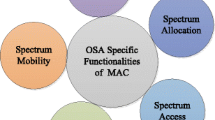Abstract
Wireless communication technology is the main reason for the advancement to mobile users. So each user demands for a separate frequency spectrum. But there is a limited frequency spectrum band. Hence there is need of an efficient communication system which first evaluates the need of frequency and then provides the frequency band to that user smartly. Cognitive Radio (CR) Technology is based on software defined radios (Mitola in Cognitive radio—an integrated agent architecture for software defined radio (Ph.D. Dissertation). KTH Royal Institute of Technology, Kista, 2000). When the frequency spectrum is used by the authorized primary user (PU), then cognitive radio provide the remaining available bandwidth to the secondary user (SU) which has very less interference with primary user. The main work of cognitive radio is to check the spectrum and find the available free channels for secondary users without affecting the primary user’s work. Universal Filtered Multicarrier (UFMC) technique gives better performance over other multicarrier techniques in term of PAPR. The work presented here is unique and novel in the sense that we have tried to incorporate the UFMC technique simultaneously in comparison with applied GFDM multicarrier modulation technique in the same wireless scenario for highlighting the contrast in the study presented here. The probable limitations of the proposed solutions after carrying out rigorous simulation testing on Matlab version 2018a have also been discussed.









Similar content being viewed by others
References
Mitola J (2000) Cognitive radio—an integrated agent architecture for software defined radio (Ph.D. Dissertation). KTH Royal Institute of Technology, Kista, Sweden, ISSN 1403–5286
Stevenson C, Chouinard G, Zhongding L, Wendong H, Shellhammer S, Caldwell W (2009) IEEE 802.22: the first cognitive radio wireless regional area network standard. IEEE Commun Mag 47:130–138
Kang X et al (2009) Sensing-based spectrum sharing in cognitive radio networks. IEEE Trans Veh Technol 58(8):4649–4654
Haykin S (2005) Cognitive radio: brain-empowered wireless communications. IEEE J Sel Areas Commun 23(2):201–220
Vakilian V, Wild T, Schaich F, Ten Brink S, Frigon J-F (2013) Universal-filtered multi-carrier technique for wireless systems beyond LTE. In: Proceedings of IEEE GLOBECOM broadband wireless access workshop, pp 223–228
Schaich F, Wild T (2014) Waveform contenders for 5G - OFDM vs. FBMC vs. UFMC. In: Proceedings of 6th international symposium on communications, control and signal processing, pp 457–460
Wang X, Wild T, Schaich F, Santos A (2014) Universal filtered multi-carrier with leakage-based filter optimization. In: European wireless, pp 963–967
Bhatnagar AC, Sharma RL, Kumar R (2012) BER improvement using windowing technique in OFDM systems. Int J Eng Innov Technol (IJEIT). 2(1)
Rahmatallah Y, Mohan S (2013) Peak-to-average power ratio reduction in ofdm systems: A survey and taxonomy. Commun Surv Tutor IEEE 15(4):1567–1592
Zhang L, Xiao S, Bi M, Liu L, Chen X (2016) FFT-based universal filtered multicarrier technology for low overhead and agile data center interconnect. In: Proceedings of international conference on transparent optical networks, pp 1–4
Mengting W, Jiang D, Zalchen Z, Liang W (2018) An advanced receiver for universal filtered multicarrier. In: IEEE publication, pp 7779–7783
Pooja M, Silki B, Himanshu M (2016) PAPR reduction methods for multicarrier modulation schemes used in next generation wireless networks-A review. Int J Broadband Cellular Commun 2(2):35–44
Krishna Kishore K et al (2017) BER and PAPR analysis of UFMC for 5G communication”, Indian Journal of Science and technology, Vol. 9, 2017.
JunMa Li, Juang BH (2009) Signal processing in cognitive radio. Proc IEEE 97:805–823
Hameed Ansari A, Gulhane SM (2015) Cyclostationary method based spectrum sensing and analysing using different windowing methods. In: International conference on energy systems and applications
Vida V, Thorsten W, Frank S, Stephan ten B, Jean FF (2013) Universal-filtered multi-carrier technique for wireless systems beyond LTE. In: IEEE global communications conference, Atlanta
Han SH, Lee JH (2005) An overview of peak-to-average power ratio reduction techniques for multicarrier transmission. Wirel Commun IEEE 12(2):56–65
Anoh K, Tanriover C, Adebisi B, Kechaou K, Anfray T, Merghem K, Berthelemot CA, Aubin G, Kazmierski C, Jany C, Chanclou P, Erasme D (2017) On the optimization of iterative clipping and filtering for PAPR reduction in OFDM systems. IEEE Access 5:12004–12013
Subhedar M, Birajdar G (2011) Spectrum sensing techniques in cognitive radio networks: a survey. Int J Next-Gener Netw (IJNGN), 3(2)
Mohite TD, Gaikwad Gholap MSSB (2014) Cognitive radio system analysis using MATLAB. Int J Emerg Technol Adv Eng 4(3):156–159
Patel R, Kumar M, Jaiswal AK, Saxena R (2013) Design technique of bandpass FIR filter using various window function. IOSR J Electron Commun Eng (IOSR-JECE), 6(6): 52–57
Kang AS, Sharma V, Gupta M (2018) GFDM and UFMC modulation techniques under dispersive wireless channels for cognitive radio-a technical review. Int J Res Publ 16(1):11
Gerzaguet R, Bartzoudis N et al (2017) The 5G candidate waveform race: a comparison of complexity and performance. Eurasip J Wirel Commun Network. 2017:1–14
Rodriguez PM, Val I, Mendicute M (2017) Evaluation of 5G modulation candidates WCP-COQAM,GFDM-OQAM, and FBMC-OQAM in low band highly dispersive wireless channels. J Comput Netw Commun. Article ID 2398701
Tang M-F, Su B (2018) Joint window and filter optimization for new waveforms in multicarrier systems. Eurasip J Adv Signal Process. https://doi.org/10.1186/s13634-018-05806-6
Acknowledgements
The authors are thankful to Research Promotion Cell, Panjab University Chandigarh for providing resources and all help to the young researchers working in the domain of communication signal processing. The first author is thankful to Dr. A. S. Kang for holding the valuable discussions on the topic under consideration. The help rendered by Mr. Vishal Sharma is also duly acknowledged herewith.
Author information
Authors and Affiliations
Corresponding author
Rights and permissions
About this article
Cite this article
Gupta, M., Kang, A.S. & Sharma, V. Comparative performance analysis of GFDM and UFMC under different window constraints for next generation cognitive radio communication. Int. j. inf. tecnol. 14, 751–760 (2022). https://doi.org/10.1007/s41870-020-00467-z
Received:
Accepted:
Published:
Issue Date:
DOI: https://doi.org/10.1007/s41870-020-00467-z




